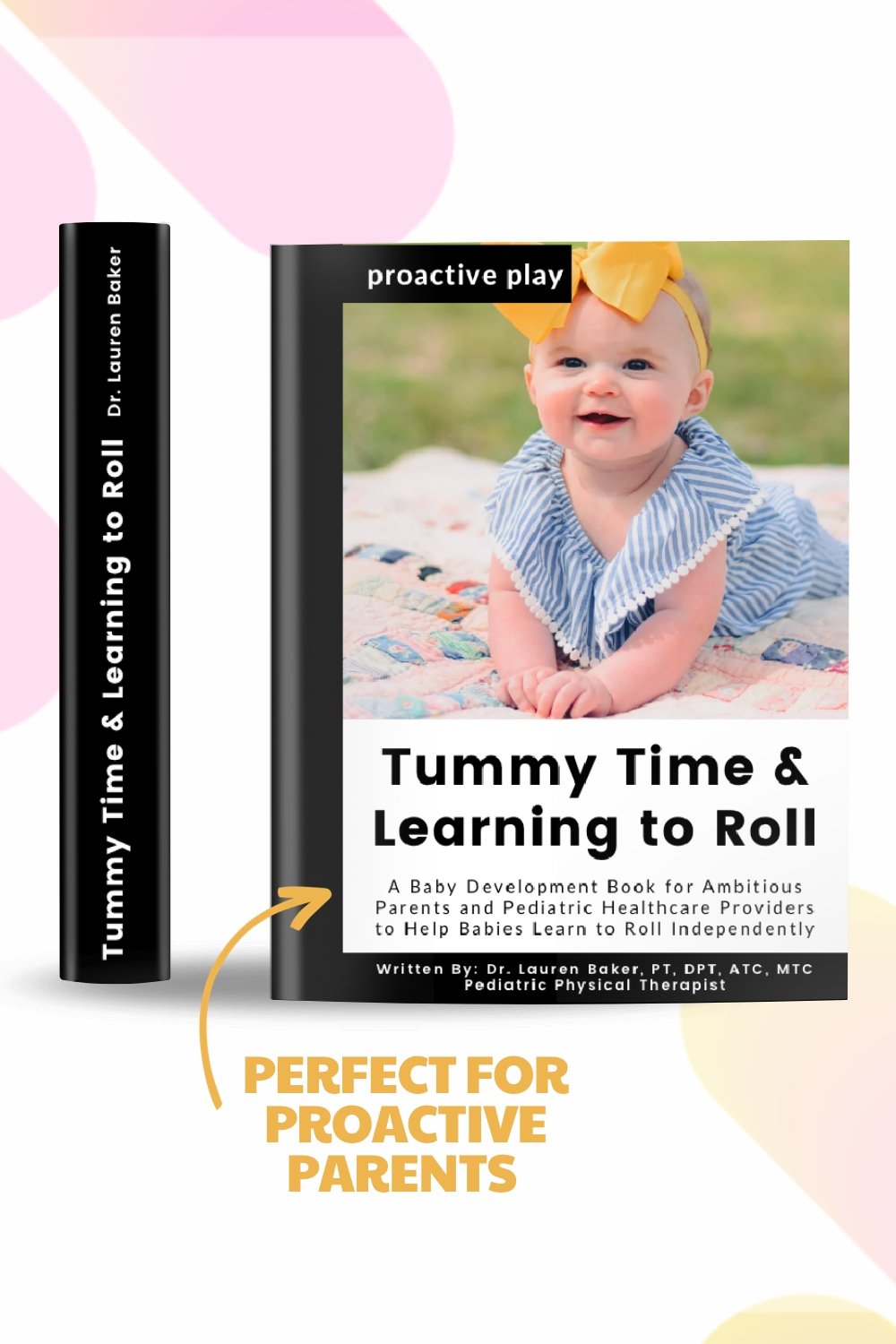Baby Struggling With Rolling Belly to Back? Try This Exercise.
Are you a proactive parent determined to help your baby achieve their developmental milestones?
Dr. Lauren Baker, a pediatric physical therapist, is here to guide you on a journey towards enhancing your baby's mobility and strength. In this blog post, we will explore the importance of tummy time, discuss exercises to help your baby bear weight through their elbows (including how to help them shift their weight onto one elbow!), and discover the secrets to independent rolling. Plus, stay tuned for an exclusive offer to boost your parenting skills with Dr. Baker's book, "Tummy Time and Learning to Roll: A Baby Development Book for Ambitious Parents and Pediatric Healthcare Providers.”
The Significance of Tummy Time:
Tummy time is more than just an adorable photo opportunity; it's a crucial building block in your baby's development. Dr. Baker emphasizes that tummy time strengthens the muscles needed for rolling, crawling, and later, walking. The American Physical Therapy Association recommends that babies engage in 60 minutes of tummy time per day by three months of age. Starting tummy time from day one, lays the foundation for their journey into being able to have the foundational skills they need to roll on their own.
Weight Bearing Through Elbows:
Some parents may notice that their baby prefers pushing through one elbow during tummy time while neglecting the other. This can be due to a variety of factors, including musculoskeletal issues like torticollis, which result in muscle imbalances. The solution? Target the weaker shoulder, focus on it strategically, and bridge the gap between strength and coordination — jump to the exercise.
What if my baby only rolls belly to back in one direction?
Rolling is a multifaceted developmental milestone and it is important that a baby is able to roll belly to back in both directions (over their left arm and over their right arm).
Why is this so important? It's all about symmetry and balance. When babies consistently roll in one direction while neglecting the other, it may indicate a restriction or limitation in the less-favored direction. This condition is referred to as an "asymmetry" in pediatric physical therapy.
Babies don't naturally have a preferred rolling direction; they usually explore both sides equally. If your baby appears to favor one side, it's crucial to address this early. Neglecting one side can lead to potential problems in the future. It’s also important to figure out the underlying reason why a baby is only rolling in one direction, because often there are things parents can do to address it at home easily with access to the right information.
Rolling Exercise to Increase Arm Strength in Babies
To support your baby's transition from belly to back, you must work on weight-bearing through one elbow. This precursor activity paves the way for independent rolling. In the video below, Dr. Baker provides a hands-on demonstration of how to help your baby bear weight through both their left and right elbows while offering valuable insights into their motor development.
How to help your baby reach with one arm to build arm strength needed for rolling belly to back:
Start with the baby on their belly
Place your hand in an open cupped shape blocking their left elbow
Create a c shape with your other hand underneath their right armpit
Rotate their upper trunk to the right while also helping them reach with your pointer finger so they reach for a toy on the ground in front of them
They may need less support at the trunk to rotate and shift their weight over their left elbow and more support at their elbow to reach in front of them with a straight arm or vice versa
Complete for 30 seconds to 1 minute on left elbow and switch
Upper Trunk Rotation:
As babies attempt to roll, they encounter the need for upper trunk rotation. If your little one struggles with this movement, they may avoid lifting one hand to play with toys on their own. Lifting an arm to reach while stabilizing their other arm on the ground, is a precursor activity to rolling from belly to back.
If a baby struggles with upper trunk rotation, make sure to purchase the Tummy Time and Learning to Roll book which walks you through how to screen this motion and exercises directly related to helping improve it on both sides. It also comes with a free video course (details in the book) to help you be able to confidently complete all the motions on your own.
In addition to upper trunk rotation, babies need the ability to shift their weight from both elbows to one elbow. Shifting their weight is complex, because it requires them to hold all their body weight on one limb instead of two – kind of like how standing on one leg is much harder than standing with both feet on the ground.
It’s the same for babies on their belly, but in order to roll from belly to back, they need to first be able to shift their weight to one elbow and reach with their opposite hand for a toy or object without collapsing. If they are able to do this equally on both sides, they are one step closer to rolling belly to back on their own, symmetrically.
Curious about learning more on Tummy Time, Rolling, or Both?
For proactive parents and healthcare providers, Dr. Lauren Baker's book, Tummy Time and Learning to Roll: A Baby Development Book for Ambitious Parents and Pediatric Healthcare Providers to Help Babies Learn to Roll Independently is an invaluable resource. Dive deeper into the world of baby development, understand the intricacies of tummy time and rolling, and empower yourself to support your baby's journey.
This book is packed with easy-to-follow information, checklists, colorful photos, and demonstration videos to make learning how to roll easily accessible for both you and the baby. Don't miss the chance to enhance your parenting skills and boost your baby's development.
The book comes with a free online video course to help parents fully understand how to complete the different exercises, printable checklists to know exactly where your baby is at, and when to reach out for additional help.
This book was written by Dr. Lauren Baker, PT, DPT, ATC, MTC, who is a Pediatric Physical Therapist in Boise, Idaho, trained in helping parents learn how to help their babies move and master their milestones. She loves teaching parents how to see how their babies are moving as well as how to influence those movements though play positions and exercises to help babies move with confidence and ease.
More information on the book:
Tummy Time and Learning to Roll is the first book in the Proactive Play series written by Pediatric Physical Therapist Dr. Lauren Baker in order to help Ambitious Parents and Pediatric Healthcare Providers learn how to help babies master tummy time and learn to roll.
It is meant to help ambitious parents understand baby development from birth to six months (tummy time to rolling). This book is a mix of easy-to-follow and more in-depth information than is typically found in baby development books because Dr. Baker believes parents deserve to have all the information at their fingertips.
This book breaks down each piece of movement in checklists so that parents know what their babies need for tummy time and rolling. It also covers what areas might limit a child with rolling, why it is so important, and when to seek help from a pediatric PT.
This book comes with colored photos and easy-to-follow demonstration videos that can help parents implement safe, strategic play-based exercises with their babies in 20 minutes per day.
A Great Resource For:
Parents and Pediatric Healthcare Providers of babies 0-6 months
Parents of babies who are struggling with tummy time, rolling back to belly, belly to back, or only to one side
Access to simple, easy-to-follow videos of play positions and exercises
Learning the four pillars of movement needed in order to master rolling
240+ Color Photo Examples of:
Tummy Time, Sidelying, and Back Play
Developmental Toys and Equipment
Hand Placement and Strategic Play Positions
Common Areas of Restriction or Weakness
When To Reach Out For Help
What If You Need Extra Help?
If your baby is struggling with rolling or you have concerns about their movement, remember, you can always reach out to a pediatric physical therapist. It's your right as a parent to advocate for your child's development. Sometimes, a few tips and tricks are all you need to get your baby moving better. We're here to support you and release those mama worries.
If you have any questions or want to schedule an online parent consultation with me, you can schedule anytime by clicking to the appointment tab or by clicking here. Or, consider reaching out to a local pediatric physical therapist who can provide insights and guidance.
Let’s embrace the adventure of babies learning to roll and help your little one conquer this exciting milestone! 👶🌟
In this blog post, we've uncovered the importance of tummy time, explored exercises to help your baby bear weight through their elbows including learning how to reach one hand out to play with a toy with support to boost rolling skills. Dr. Lauren Baker is your go-to resource for understanding and facilitating your baby's journey to mobility. With her book in hand, you'll have all the knowledge and guidance you need to become the proactive parent you want to be for your baby. Don't wait; take the first step toward empowering your baby's growth and development today.
To purchase or learn more about the book click here



